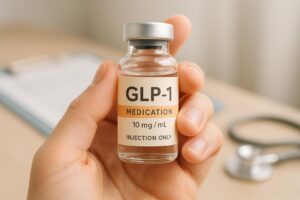How Does GLP-1 Work in the Body?

The intricate dance of hormones in our body often leaves us wondering how they influence our health, particularly concerning weight management and metabolic disorders. One such hormone, glucagon-like peptide-1 (GLP-1), has gained significant attention for its role in regulating blood sugar levels and contributing to weight loss.
Did you know that approximately 42% of adults in the United States are classified as obese, according to the Centers for Disease Control and Prevention (CDC)? This staggering statistic underlines the urgent need for effective weight management solutions. As we delve into the mechanisms of GLP-1, we will explore how it functions within the body, its therapeutic applications, particularly in weight loss, and how TrimRx’s personalized weight loss programs can help individuals on their journey toward better health.
Introduction
The journey of understanding GLP-1 begins in the small intestine, where it is secreted in response to food intake. Historically, the significance of GLP-1 was primarily associated with its function in glucose homeostasis; however, recent research has illuminated its multifaceted roles, especially in appetite regulation and weight management. By the end of this article, you will have a comprehensive understanding of how GLP-1 works in the body and the potential benefits of GLP-1 receptor agonists in managing obesity and type 2 diabetes.
Throughout this post, we will unpack the biological functions of GLP-1, the mechanisms through which GLP-1 receptor agonists operate, their therapeutic uses, and why a personalized approach to weight loss—such as that offered by TrimRx—can make a significant difference in achieving sustainable results.
As we navigate this topic, we will also highlight how GLP-1 can serve as a powerful ally in your weight loss journey, encouraging you to reflect on how these insights may be relevant to your personal health goals. Our aim is not only to inform but also to empower you with knowledge that could lead to meaningful changes in your life.
Understanding GLP-1: The Basics
What is GLP-1?
GLP-1 is an incretin hormone produced by the intestinal L-cells in response to food consumption. It plays a crucial role in managing glucose levels by promoting insulin secretion and inhibiting glucagon release. By facilitating the uptake of glucose into cells, GLP-1 helps maintain blood sugar levels within a normal range, making it particularly relevant for individuals with type 2 diabetes.
The Role of GLP-1 in the Body
-
Insulin Secretion: GLP-1 enhances the secretion of insulin from the pancreas, particularly after meals, which helps lower blood glucose levels.
-
Glucagon Suppression: It reduces the secretion of glucagon, a hormone that typically raises blood sugar levels, thus contributing to better glycemic control.
-
Gastric Emptying: GLP-1 slows gastric emptying, leading to a prolonged feeling of fullness after eating. This delay can help reduce overall calorie intake.
-
Appetite Regulation: By acting on the brain’s appetite centers, GLP-1 reduces hunger and can lead to decreased food consumption.
These functions make GLP-1 a critical player in both metabolic regulation and appetite control.
How Do GLP-1 Receptor Agonists Work?
GLP-1 receptor agonists are synthetic medications designed to mimic the effects of naturally occurring GLP-1. They bind to GLP-1 receptors throughout the body, triggering similar biological responses, which contribute to their therapeutic effects.
Mechanisms of Action
-
Enhanced Insulin Secretion: Just like GLP-1, these medications stimulate insulin release in a glucose-dependent manner, meaning they help increase insulin levels when blood sugar is elevated.
-
Reduced Glucagon Levels: By suppressing glucagon release, GLP-1 receptor agonists help prevent the liver from producing excess glucose, further aiding in blood sugar control.
-
Delayed Gastric Emptying: This action leads to increased satiety and reduced appetite, facilitating weight loss. Patients often report feeling fuller for longer periods, which can help in managing caloric intake.
-
Neurotransmitter Activity: Research suggests that GLP-1 receptor agonists also influence neurotransmitter systems in the brain to regulate appetite and cravings, making it easier to adhere to dietary changes.
Common GLP-1 Receptor Agonists
Several GLP-1 receptor agonists are available, including:
- Semaglutide (Ozempic, Wegovy): Approved for both type 2 diabetes and chronic weight management.
- Liraglutide (Victoza, Saxenda): Used for diabetes management and weight loss.
- Tirzepatide (Mounjaro, Zepbound): A dual-action medication that targets GLP-1 and GIP receptors, enhancing weight loss results.
Each of these medications offers unique benefits, and their effectiveness may vary based on individual health conditions and treatment goals.
The Therapeutic Benefits of GLP-1 Receptor Agonists
Weight Loss
One of the most significant benefits of GLP-1 receptor agonists is their ability to promote weight loss. Clinical studies have demonstrated that individuals using these medications can achieve substantial weight reductions—often exceeding 10% of body weight—when combined with lifestyle modifications. This effect is largely attributed to:
- Reduced Caloric Intake: The appetite-suppressing effects of GLP-1 receptor agonists lead to lower food consumption.
- Enhanced Satiety: The delayed gastric emptying results in longer-lasting feelings of fullness after meals.
Blood Sugar Control
For individuals with type 2 diabetes, GLP-1 receptor agonists serve as an effective component of a comprehensive diabetes management plan. They help in achieving better glycemic control, reducing HbA1c levels, and minimizing the risk of diabetes-related complications.
Cardiovascular Benefits
Emerging evidence suggests that GLP-1 receptor agonists may offer cardiovascular protection. Studies have indicated that these medications can lower the risk of major adverse cardiovascular events in individuals with type 2 diabetes, making them a valuable option for those with concurrent cardiovascular risks.
Integrating GLP-1 Therapy into Your Weight Loss Journey
At TrimRx, we understand that each individual’s weight loss journey is unique. Our personalized weight loss programs are designed to integrate the power of GLP-1 receptor agonists with a tailored approach to care.
Personalized Assessment
The first step in our process is a free assessment quiz that helps determine eligibility for our prescription weight loss medications, including GLP-1 receptor agonists. This personalized evaluation allows us to craft a treatment plan that aligns with your specific health needs and goals. Take our free assessment quiz today!
Comprehensive Support
Our offerings encompass more than just medication. We provide a holistic approach that includes:
- Doctor Consultations: Regular check-ins with our medical team to monitor progress and adjust plans as needed.
- Lab Work: Comprehensive lab testing to assess individual health metrics and inform treatment strategies.
- Unlimited Support: Continuous access to our support team to address questions and provide encouragement throughout your weight loss journey.
- Shipping from FDA-Registered Pharmacies: Assurance that your medications are sourced from safe, inspected facilities.
Together, we can create a tailored weight loss plan that is not only effective but also sustainable. By combining science with empathy, we aim to empower you on your path to achieving your health goals.
Additional Support Supplements
In addition to our prescription options, we also offer quick-access supplements that can complement your weight loss efforts:
- GLP-1 Daily Support: Formulated to enhance the effects of GLP-1 therapy.
- Weight Loss Boost: Designed to provide an additional edge in your weight loss journey.
These supplements can offer the necessary support as you navigate your personal weight loss journey.
Conclusion
Understanding how GLP-1 works in the body reveals its essential role in managing weight and blood sugar levels. Through its multifaceted actions—enhancing insulin secretion, suppressing glucagon, delaying gastric emptying, and regulating appetite—GLP-1 serves as a powerful ally in the fight against obesity and type 2 diabetes.
At TrimRx, we embrace the mission of providing personalized, medically supervised weight loss solutions that empower individuals to achieve their health goals. Our comprehensive approach, coupled with the benefits of GLP-1 receptor agonists, equips you with the tools needed for sustainable weight loss and improved health.
If you’re ready to take the next step, we invite you to take our free assessment quiz to explore how our personalized programs can work for you. Together, we can navigate your path to a healthier, happier you.
FAQ
What is GLP-1 and why is it important?
GLP-1 is a hormone that plays a vital role in glucose regulation and appetite control. It enhances insulin secretion and lowers blood sugar levels, making it crucial for managing type 2 diabetes and obesity.
How do GLP-1 receptor agonists help with weight loss?
GLP-1 receptor agonists mimic the effects of GLP-1, leading to reduced appetite, increased feelings of fullness, and slower gastric emptying, which collectively contribute to weight loss.
Are there side effects associated with GLP-1 receptor agonists?
Yes, common side effects may include nausea, vomiting, and gastrointestinal discomfort. It’s important to discuss potential side effects with your healthcare provider.
Can I take GLP-1 receptor agonists if I don’t have diabetes?
Yes, certain GLP-1 receptor agonists are approved for weight management in individuals without diabetes who meet specific criteria.
How does TrimRx support my weight loss journey?
TrimRx provides a personalized approach, including a free assessment quiz, doctor consultations, lab work, unlimited support, and medications shipped from FDA-registered pharmacies, all designed to support you in achieving sustainable weight loss.

Transforming Lives, One Step at a Time
Keep reading
Tracking Progress With GLP-1: What To Measure
Learn which metrics to track on GLP‑1 therapy—weight, waist, blood sugar, lipids, side effects, and non‑scale wins—and how often to monitor them.
Fatigue Solutions for Ozempic and Wegovy Users
Hydration, protein-rich meals, light activity, and better sleep can reduce medication-related fatigue and help maintain energy during weight-loss treatment.
GLP-1 Medication Side Effect Checker
Worried about GLP-1 medication side effects? Use our free checker for Semaglutide, Liraglutide, and more to learn what to expect and stay informed!



